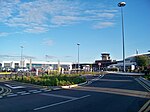Leeds Bradford Airport (IATA: LBA, ICAO: EGNM) is located in Yeadon, in the City of Leeds Metropolitan District in West Yorkshire, England, about 7 miles (11 km) northwest of Leeds city centre, and about 9 miles (14 km) northeast from Bradford city centre. It serves Leeds and Bradford and the wider Yorkshire region including York, Wakefield and Harrogate, and is the largest airport in Yorkshire. The airport was in public ownership until May 2007, when it was bought by Bridgepoint Capital for £145.5 million. Bridgepoint sold it in 2017 to AMP Capital.Leeds Bradford opened on 17 October 1931 when it was known as Leeds and Bradford Municipal Aerodrome or Yeadon Aerodrome; some locals still refer to it as Yeadon Airport. Largely used for general aviation and training purposes early on, the first scheduled flights commenced on 8 April 1935. To accommodate passenger traffic, work commenced on the first terminal in the late 1930s, although only the first wing was completed before the Second World War.
British aircraft manufacturer Avro constructed a shadow factory called the Leeds Bradford Airport Depot to the north of the airport, which was the largest free-standing structure in Europe at that time. Avro produced around 5,515 aircraft before it closed in December 1946 and civil flights recommenced the following year. It is located where Leeds Bradford Airport Industrial Estate is today.In 1965, a new runway opened. After Yeadon's terminal was destroyed in a fire, a replacement was completed in 1968. In the early 1980s, runway extensions were completed that enabled it to be classified as a regional airport. On 4 November 1984, the day a runway extension was opened, Wardair commenced transatlantic flights to Toronto, using Boeing 747s. On 2 August 1986, an Air France Concorde charter flight from Paris landed for the first time, drawing an estimated crowd of 70,000 people. More Concorde charter flights took place until 2000. In 1994, the airport's operational hour restrictions were removed, enabling flights at any time of day. Since 1996, the terminal has been expanded in the terms of size and facilities. In 2007, nearly 2.9 million passengers passed through the airport, an 88% increase in seven years and more than twice as many compared with 1997 (1.2 million).
Leeds Bradford has a CAA Public Use Aerodrome Licence (Number P800) that allows flights for passenger transport and flight training. The airport operates to many domestic and European destinations. It is the highest airport in England at an elevation of 681 ft (208 m). By the number of passengers handled in 2018, Leeds Bradford was the 15th busiest airport in the UK. It is a base for Jet2.com, which has its headquarters at the airport.











